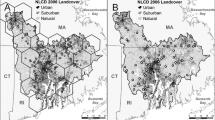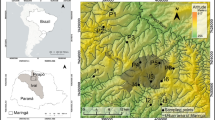Abstract
The Direct/Delayed Response Project (DDRP) is one of several studies being conducted by the United States Environmental Protection Agency to assess risk to surface waters from acidic deposition in the eastern United States. In one phase of DDRP, land use, wetland, and forest cover data were collected for statistical samples of 145 Northeast lake and 35 Southern Blue Ridge Province stream watersheds in the United States. Land-use and other data then were extrapolated from individual to target watershed populations. Project statistical design allows summarization of results for various subsets of the target population. This article discusses results and implications of the land-use and land-cover characterization for both regions.
Forest cover was the primary land use in both regions. In the Northeast, developed (agriculture and urban) land was positively associated with surface-water chemistry values for acid neutralizing capacity, Ca plus Mg, pH, and sulfate in the Pocono/Catskill subregion. Extensive wetlands and beaver activity occur in parts of the Northeast region, whereas topography limits wetland and riparian development in the Southern Blue Ridge Province. Northeast soils have low sulfate adsorption capacity, most watersheds are near sulfur steady state, and lake sulfate concentrations are controlled principally by levels of sulfur deposition. Net annual sulfur retention in Northeast watersheds is positively correlated with occurrence of wetlands and beaver impoundments. In contrast, most Southern Blue Ridge Province soils have high sulfate adsorption capacities, resulting in high net watershed sulfur retention. At the present time, stream sulfate concentrations and percent sulfur retention are controlled principally by soil chemical properties related to adsorption rather than atmospheric deposition and land use.
Similar content being viewed by others
Literature Cited
Anderson, J. R., E. E. Hardy, J. T. Roach, and R. E. Witmer. 1976. A land use and land cover classification system for use with remote sensor data. US Government Printing Office, Washington, DC. Geological Survey Professional Paper 964. 28 pp.
Bogucki, D. J., G. K. Gruendling, E. B. Allen, K. B. Adams, and M. M. Remillard. 1986. Photointerpretation of historical (1948–1985) beaver activity in the Adirondacks. Pages 299–308in Proceedings of the ASPRS-ACSM Fall Convention. 28 September–3 October 1986. Anchorage, Alaska.
Bormann, F. H., and G. E. Likens. 1979. Pattern and process in a forested ecosystem. Springer-Verlag, New York. 253 pp.
Buso, D. C., S. W. Bailey, S. F. Baird, J. W. Hornbeck, and C. W. Martin. 1985. Watershed interactions affecting pond acidification. Research Report No. 62. New Hampshire Water Resource Research Center, Durham, New Hampshire, 61 pp.
Chang, M., J. D. McCullough, and A. B. Granillo. 1983. Effects of land use and topography on some water quality variables in forested East Texas.Water Resources Bulletin 19(2):191–196.
Church, M. R. 1989. Direct/Delayed Response Project: Predicting future long-term effects of acidic deposition on surface water chemistry.EOS, Transactions, American Geophysical Union 70(35):801–803, 812–813.
Church, M. R., K. W. Thornton, P. W. Shaffer, D. L. Stevens, B. P. Rochelle, G. R. Holdren, M. G. Johnson, J. J. Lee, R. S. Turner, D. L. Cassell, D. A. Lammers, W. G. Campbell, C. I. Liff, C. C. Brandt, L. H. Liegel, G. D. Bishop, D. C. Mortenson, S. M. Pierson and D. D. Schmoyer. 1989. Direct/Delayed Response Project: Future effects of long-term sulfur deposition on surface water chemistry in the Northeast and southern Blue Ridge Province. US Environmental Protection Agency, Washington, DC. EPA/600/3-89/061a-d. 887 pp.
Cochran, W. G. 1977. Sampling techniques. John Wiley & Sons, New York. pp. 259–261.
Cooper, J. R., J. W. Gillam, and T. C. Jacobs. 1986. Riparian areas as a control of nonpoint pollutants. Pages 166–192in D. L. Correll (ed.), Watershed Research Perspectives. Smithsonian Institution Press, Washington, DC.
Cowardin, L. M., V. Carter, F. C. Golet, and E. T. LaRoe. 1979. Classification of wetlands and deepwater habitats of the United States. Biological Services Program, US Department of the Interior, Fish and Wildlife Service, Washington, DC. FWS/OBS-79-31. 131 pp.
Cronan, C. S., J. C. Conlan, and S. Skibinski. 1987. Forest vegetation in relation to surface water chemistry in the north branch of the Moose River, Adirondack Park, NY.Biogeochemistry 3:121–128.
Dillon, P. J., and W. B. Kirchner. 1975. The effects of geology and land use on the export of phosphorus from watersheds.Water Research 9:135–148.
Driscoll, C. T., B. J. Wyskowski, C. C. Cosentini, and M. E. Smith. 1987. Processes regulating temporal and longitudinal variations in the chemistry of a low-order woodland stream in the Adirondack region of New York.Biogeochemistry 3:225–241.
Goldstein, R. A., S. A. Gherini, C. T. Driscoll, R. April, C. L. Schofield, and C. W. Chen. 1987. Lake-watershed acdification in the north branch of the Moose River: Introduction.Biogeochemistry 3:5–20.
Haines, T. A., and J. Akielaszek. 1983. A regional survey of the chemistry of headwater lakes and streams in New England: Vulnerability to acidification. Air pollution and acid rain. US Department of the Interior, Fish and Wildlife Service, Washington, DC. FWS/OBS-80/40.15. 141 pp.
Hunsaker, C. T., S. W. Christensen, J. J. Beauchamp, R. J. Olson; R. S. Turner, and J. L. Malanchuk. 1986a. Empirical relationships between watershed attributes and headwater lake chemistry in the Adirondack region. Oak Ridge National Laboratory, Environmental Sciences Division, Oak Ridge, Tennessee. Pub. No. 2884. 123 pp.
Hunsaker, C. T., J. L. Malanchuk, R. J. Olson, S. W. Christensen, and R. S. Turner. 1986b. Adirondack headwater lake chemistry relationships with watershed characteristics.Water, Air, and Soil Pollution 31:79–88.
Jeffries, D. S., J. R. M. Kelso, and I. K. Morrison. 1988. Physical, chemical, and biological characteristics of the Turkey Lakes watershed, central Ontario, Canada.Canadian Special Publication on Fisheries and Aquatic Science 45(Suppl. 1):3–13.
Johnston, C. A., G. D. Bubenzer, G. B. Lee, F. W. Madison, and J. R. McHenry. 1984. Nutrient trapping by sediment deposition in a seasonally flooded lakeside wetland.Journal of Environmental Quality 13(2):283–290.
Johnston, C. A., N. E. Detenbeck, J. P. Bonde, and G. J. Niemi. 1988. Geographic information systems for cumulative impact assessment.Photogrammetric Engineering and Remote Sensing 54(11):1609–1615.
Kaufmann, P. R., A. T. Herlihy, J. W. Elwood, M. E. Mitch, W. S. Overton, M. J. Sale, J. J. Messer, K. A. Cougan, D. V. Peck, K. H. Reckhow, A. J. Kinney, S. J. Christie, D. D. Brown, C. A. Hagley, and H. I. Jager. 1988. Chemical characteristics of streams in the mid-Atlantic and southeastern United States. Volume I: Population descriptions and physico-chemical relationships. US Environmental Protection Agency, Washington, DC. EPA/600/3-88/021a. 397 pp.
Kirchner, W. B. 1975. An examination of the relationships between drainage basin morphology and the export of phosphorus.Limnology and Oceanography 20(2):267–269.
Lawrence, G. B., and C. T. Driscoll. 1988. Aluminum chemistry downstream of a whole-tree-harvested watershed.Environmental Science and Technology 22:1293–1299.
Lee, J., R. Church, D. Lammers, L. Liegel, M. Johnson, D. Coffey, R. Holdren, D. Stevens, R. Turner, and L. Blume. 1989. Watershed surveys to support an assessment of the regional effects of acidic deposition on surface water chemistry.Environmental Management 13(1):95–108.
Likens, G. E., and F. H. Bormann. 1974. Linkages between terrestrial and aquatic ecosystems.Biosciene 24(8):447–456.
Linthurst, R. A., D. H. Landers, J. M. Eilers, D. F. Brakke, W. S. Overton, E. P. Meier, and R. E. Crowe. 1986. Characteristics of lakes in the eastern United States. Volume I. Population descriptions and physico-chemical relationships. US Environmental Protection Agency, Washington, DC. EPA/600/4-86/007a. 136 pp.
McDaniel, T. W., C. T. Hunsaker, and J. J. Beauchamp. 1987. Determining regional water quality patterns and their ecological relationships.Environmental Management 11(4):507–518.
Morgan, M. D., and R. E. Good. 1988. Stream chemistry in the New Jersey pinelands: The influence of precipitation and watershed disturbance.Water Resources Research 24(7):1091–1100.
Mortenson, D. C. 1989a. Geographic information system documentation of watershed data for Direct/Delayed Response Project—Northeast databases. US Environmental Protection Agency, Corvallis, Oregon. ERL-COR-519. EPA/600/3-89/001 and Project Summary. 51 pp.
Mortenson, D. C. 1989b. Geographic information system documentation of watershed data for Direct/Delayed Response Project—Southern Blue Ridge Province database. US Environmental Protection Agency, Corvallis, Oregon. ERL-COR-535, EPA/600/3-89/002 and Project Summary. 34 pp.
Naiman, R. J., J. M. Mclillo, and J. E. Hobbie. 1986. Ecosystem alterations of boreal forest streams by beaver (Castor canadensis).Ecology 67(5):1254–1269.
Omernik, J. M. 1977. Nonpoint source-stream level relationships: A nationwide study. US Environmental Protection Agency, Corvallis, Oregon. EPA-600/3-77/105. 151 pp.
Osborne, L. L., and M. J. Wiley. 1989. Empirical relationships between land use/cover and stream water quality in an agricultural watershed.Journal of Environmental Management 26:9–27.
Overton, W. S. 1985. Draft sampling plan for phase I of the NSS. US Environmental Protection Agency, Corvallis, Oregon (mimco).
Overton, W. S. 1987. Phase II analysis plan, national lake survey. Department of Statistics, Oregon State University, Corvallis, Oregon. Tech. Rep. No. 115.
Pritchett, W. L., and R. F. Fisher. 1987. Properties and management of forest soils, 2nd ed. John Wiley & Sons, New York. 494 pp.
Rochelle, B. P., C. I. Liff, W. G. Campbell, D. L. Cassell, M. R. Church, and R. A. Nusz. 1989. Regional relationships between geomorphic/hydrologic parameters and surface water chemistry relative to acidic deposition.Journal of Hydrology 112:103–120.
Schlosser, I. J., and J. R. Karr. 1981. Riparian vegetation and channel morphology impact on spatial patterns of water quality in agricultural watersheds.Environmental Management 5(3):233–243.
Schnabel, R. R. 1985. Nitrate concentrations in a small stream as affected by chemical and hydrologic interactions in the riparian zone. Pages 263–282in D. L. Correll (ed.), Watershed Research Perspectives. Smithsonian Institution Press, Washington, DC.
Stone, L. J. 1974. A study: Effects of geology and nutrients on water-quality development.Journal of American Waterworks Association 66(8):489–494.
Swank, W. T., and D. A. Crossley, Jr. (eds.). 1987. Forest hydrology and ecology at Coweeta. Ecological studies Vol. 66. Springer-Verlag, New York. 512 pp.
Thomas, G. W., and J. D. Crutchfield. 1974. Nitrate-nitrogen and phosphorus contents of streams draining small agricultural watersheds in Kentucky.Journal of Environmental Quality 3(1):46–49.
Tiedemann, A. R., T. M. Quigley, and T. D. Anderson. 1988. Effects of timber harvest on stream chemistry and dissolved nutrient losses in northeast Oregon.Forest Science 34(2):344–358.
Author information
Authors and Affiliations
Additional information
The information in this document has been funded wholly by the United States Environmental Protection Agency. It has been subjected to the agency's peer and administrative review, and it has been approved for publication as an EPA document. Mention of trade names or commercial products does not constitute endorsement or recommendation for use.
Rights and permissions
About this article
Cite this article
Liegel, L., Cassell, D., Stevens, D. et al. Regional characteristics of land use in Northeast and Southern Blue Ridge Province: Associations with acid rain effects on surface-water chemistry. Environmental Management 15, 269–279 (1991). https://doi.org/10.1007/BF02393859
Issue Date:
DOI: https://doi.org/10.1007/BF02393859




